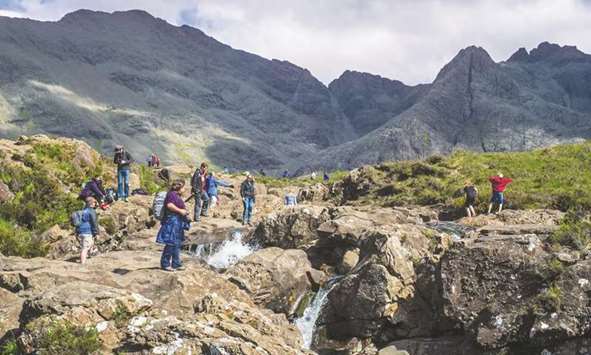Residents on the Scottish island of Skye are calling for urgent help to deal with overcrowding after a surge in tourism led to too many visitors at some of the island’s most famous beauty spots.
Islanders complain that their narrow, single-track roads are being choked with camper vans, tour buses and cars, that litter is strewn around stopping places, and visitors are going to the toilet in the open.
The problem is most acute at Skye’s most famous spots, particularly at the fairy pools – a series of vivid green and blue pools and waterfalls in Glen Brittle – the Neist Point lighthouse with views over to the Uist islands, and the island’s remarkable ridges and stone outcrops at the Quiraing and the Old Man of Storr.
“Skye is buckling under the weight of increased tourism this year,” said Rob Ware, who lets a self-catering cottage on the south of the island.
“It’s not everywhere on the island: the reality is that there are lots of places which aren’t suffering too much but it’s the key iconic destinations, like the Old Man of Storr and the Quiraing.”
After decades of relative isolation and depopulation, Skye has recently become a must-see destination for hundreds of thousands of overseas visitors, particularly from the US, most of whom visit for a day or 48 hours and converge on only four or five of its most famous sites.
Its popularity has been driven by Holywood, pop stars, commercials and social media, which in turn have been promoted heavily by the tourism agency VisitScotland and Scottish ministers, who are anxious to attract high-spending foreign visitors.
That has been accelerated by TV shows such as the Highland fantasy epic Outlander, which opens with an adaptation of the Skye Boat Song, a recent advert for a new Volvo which featured its dramatic seascapes and the Quiraing, and even Harry Styles, the former One Direction star: the video for Sign of the Times features him appearing to fly over Skye.
Ware said those tensions erupted earlier this week after a tour bus trying to park disturbed a family funeral at a church in Glen Brittle, a secluded glen on the west side of Skye’s famous Cuillin mountains.
One mourner wrote to the tour company, urging them to stay off Skye.
Locals routinely find it impossible to drive through the cars, coaches and campervans clogging the single-track road.
Fears are raised, too, that the traffic jams could prevent mountain rescue teams reaching Skye’s mountain rescue headquarters in Glen Brittle.
Ware also points to the pressure on affordable housing for locals.
The surge in visitors is economically vital, but has raised housing costs and squeezed out local families and workers.
The number of Airbnb lettings on Skye has jumped, he said, from 54 in 2015 to 360 this summer, including established self-catering cottages such as his, to yurts, spare rooms and sheds.
Highland council has been under fire for closing down public toilets, adding to the pressure on local hotels and bars, or leading visitors to relieve themselves outdoors.
The council said it was reviewing the availability of public toilets and car parks across the region, but had no cash left for emergency projects.
Shirley Spear, who runs the Three Chimneys restaurant near Dunvegan castle, one of two Michelin-starred restaurants on Skye, is coordinating a new campaign with Ware to win emergency funding to help and devise a long-term tourism strategy, says there has been decades of under-investment in basic infrastructure.
Family cars are now much larger and tour buses proliferate.
“All heading for the same place, taking thousands of people down these pathways. They’re deteriorating and everyone is parking the verge, which become quite muddy, rutted and dangerous. It’s causing problems for parking and blocking the pathways for emergency vehicles and people who live in these areas,” she said.
Precise visitor statistics for Skye are difficult to obtain but VisitScotland says more than 150,000 people visited its centre in Portree, Skye’s largest town last year, 5% up on 2015.
More than 24,000 people visited the centre in June this year, again 5% up on 2016.
The boom in coastal cruises around Scotland which has threatened to overwhelm parts of the Orkney islands has also arrived on Skye.
More than 30 cruise ships are scheduled in moor in Portree bay this summer, each for less then a day and some with 2,200 passengers on board, who are then ferried onto waiting coaches for whistle-stop tours of the most famous sites.
Kate Forbes, the MSP for Skye, Lochaber and Badenoch, has been helping coordinate a new strategic plan with the council, Scottish ministers and local groups with extra money offered to Highland council to help it cope.
That included building a much larger 150-space car park in Glen Brittle, and strengthening roadsides at the worst-affected areas.
But Forbes says visitors too need to act with sensitivity, showing “basic common courtesy” at passing places on single-track roads, and on finding proper toilets.
“There is a strong message that you are welcome on Skye but please respect Skye,” she said.
Chris Taylor, VisitScotland’s north regional director, who covers Skye, said the agency was supporting efforts to find a long-term solution involving islanders, landowners, Highland council and the government.
“I understand these issues.They’re very real for people and very immediate, and it does have an impact,” he said. “But the benefits to Skye of bringing in international visitors and increased spending are huge.”

Tourists at the fairy pools, a group of waterfalls in Glen Brittle on the Isle of Skye.


